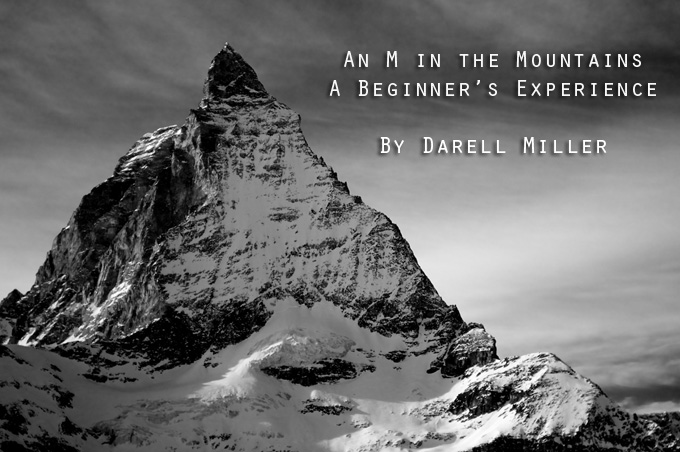
M in the Mountains – A Beginner’s Experience
By Darell Miller
**All photos were shot with a vintage 1961 50 Summilux
I come alive in the mountains. The sense of silent power, crystal clear air, and hushed awe lifts all my senses. On a clear day the sky is a deep delirious blue that that you can almost drink in and just looking at it refreshes exhausted legs after a 2km thigh burning black diamond ski trail. Exhilarated and relaxed at the same time, I am in my element.
I have always longed to be able to capture some of that mountain magic I feel in my photographs but when using digital compacts had not really done anything more than point and shoot and failed. Things started to change last year when through an email conversation with Steve I took my first steps to serious considered photography I bought an Olympus EP2. Six months later after having used some M series lenses on the EP2 I signed up for Steve’s meetup in NYC and managed to pickup a secondhand M8 through the Leica Forum. Now I really stared to learn about the elements that produce an image and actually have control over it. My photos from NY weren’t fantastic but I was learning and loving the process. Now if i could just combine this with my great love of the mountains and skiing that would be great!
Sun, Snow & Wind
–
The problem was that I normally go skiing with my teenage son who isn’t all that tolerant of my taking photos at the best of times, I slow everything up apparently, and not at all when there’s skiing to be done. This combined with all the kit I have to carry in my backpack for the two of us when we are skiing meant that the best I could hope for was some quickly snatched shots on my EP2, which wasn’t my aim. I was chatting about the problem with my friend Luke, a Canon user and a far better photographer than me, when he came up with a fantastic solution “How about a boy’s skiing and photography weekend in Cervinia, Italy?” Well that didn’t take much thinking about I can tell you! Once we had both obtained the vital green light from our wives it was full steam ahead.
Now came the vexed question of kit. Lenses were easy, my 28mm Voigtlander and my vintage 50mm Summilux were the obvious choices, but a Billingham Hadley Pro is hardly the ideal bag for skiing with. A backpack is more practical but makes it difficult to get at your camera quickly. Here Luke came up trumps again as he uses the Lowe Pro Slingshot as a light weight quick access bag for his Canon and a lens. This is a single strap backpack but with aside strap which holds the bag more firmly in place which can be unclipped from the sling in front of you. This means the whole bag can be swiveled around your body and opened up from the side entry zip with no chance of your camera falling out, even on a ski lift! If you are into active sports and want to take your M this is definitely a bag to consider. With an M8 and two lenses it still has room for a spare sweater in the main compartment, vital when the temperature gets down to -27 degrees Centigrade.
So one Friday evening in we found ourselves touching down in Turin in the north of Italy. For those who haven’t been there Turin is one of the major industrial cities in Italy, the home to Fiat cars, and is located in a bowl literally surrounded by mountains. For a skier it would be heaven to work here as your are no more than an hour and half drive from some serious ski resorts. Oh and if you want to know what it looks like then just watch the original 1960’s Italian Job movie as the whole robbery sequence is set in Turin, don’t get me started on Mini Coopers.
Early Saturday morning we are up and ready to drive form our hotel to the slopes, and I mean early, the Moon hadn’t even set yet and the Sun was barely peeking over the top of the surrounding mountains.
Early start for the slopes
–
Cervinia itself is right up on the Swiss/Italian border where you can ski down into the Swiss town of Zermatt and both resorts play host to one of the most iconic mountains in Europe, the Matterhorn. This really is mountain straight form your childhood imagination, especially when seen from the Swiss side. A perfect pyramid of rock, snow, and ice towering over everything else, it punctures the sky like an exclamation mark. Needless to say there were many attempts made to capture its extraordinary beauty and I hope I have done it some justice here and in the first photograph.
Majestic Matterhorn
–
Complementing the Matterhorn is the seemingly endless Aosta valley. A sinuous, winding corridor of snow clad peaks reaching down from the border with many wonderful ski resorts along its sides.
What followed was two and a half days of bitingly blue skies (it really did get down to -27 at one point!), fantastic skiing, great food and wine (well we were in Italy) and lots of photography. Here are a few more of my favourite shots from this amazing weekend.
–
Matterhorn Towering over Cervinia
–
Last of the day’s Sun
–
Luke and his Canon
–
Luke carving a turn in front of the Matterhorn
–
–
I thought I’d finish in the style of Steve’s & Seal’s M9 contest with two images that for me define why I love the mountains. Thanks for reading.
Heaven is a place on Earth
[ad#Adsense Blog Sq Embed Image]

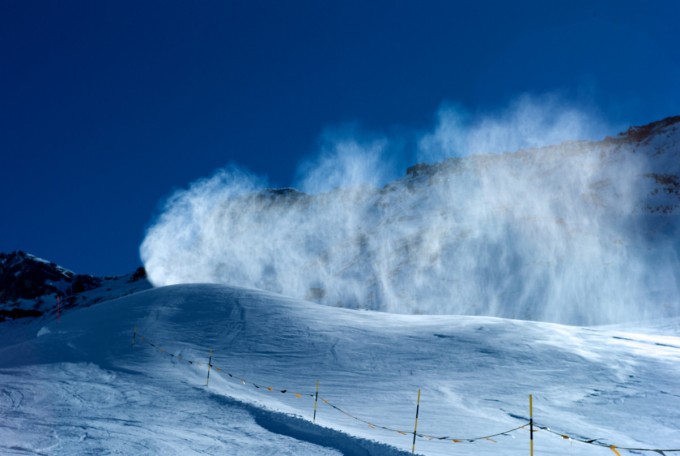
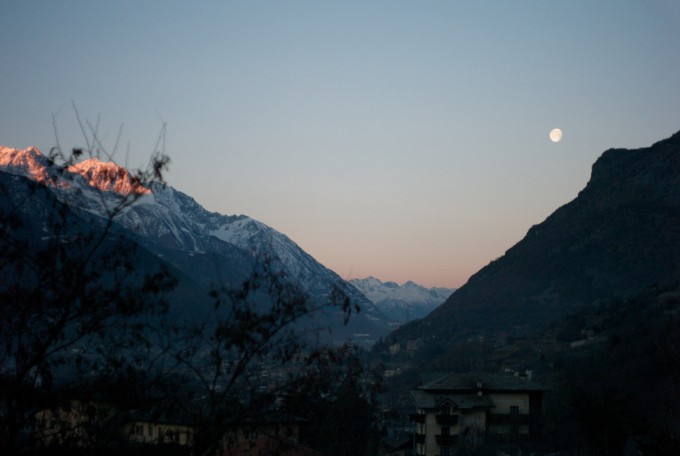
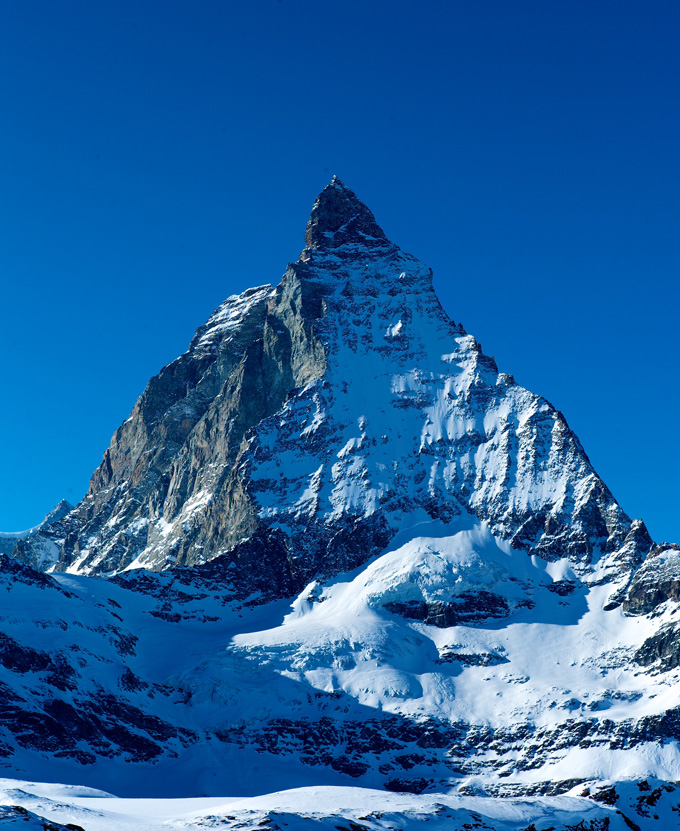
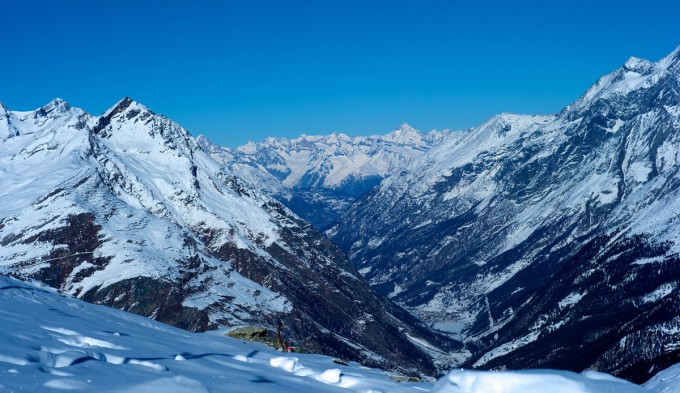
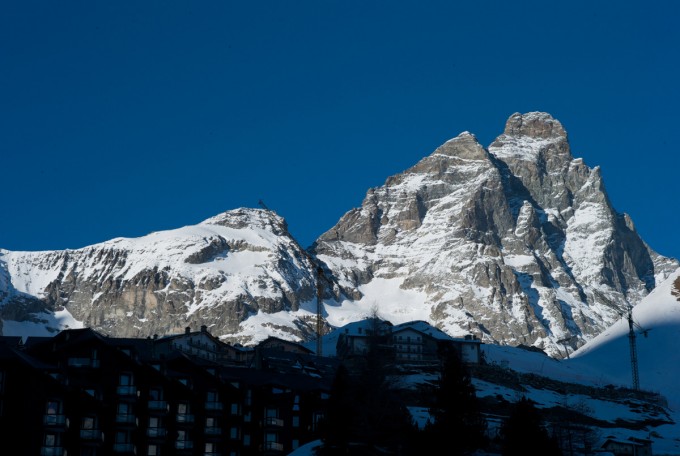
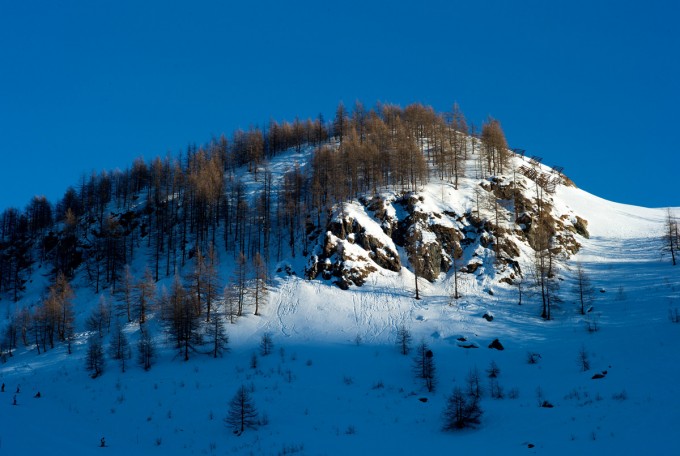
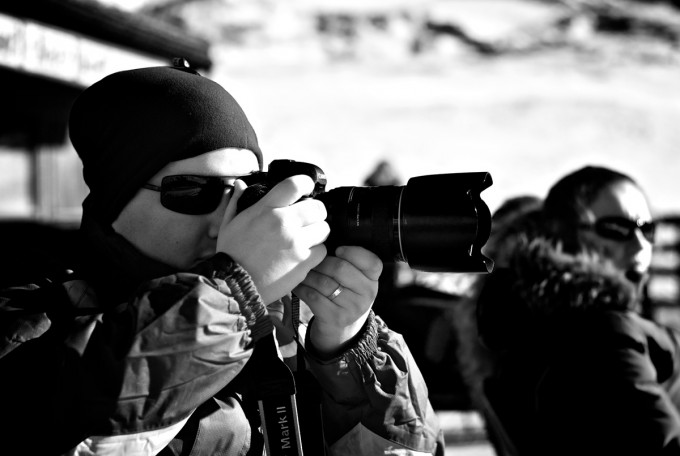
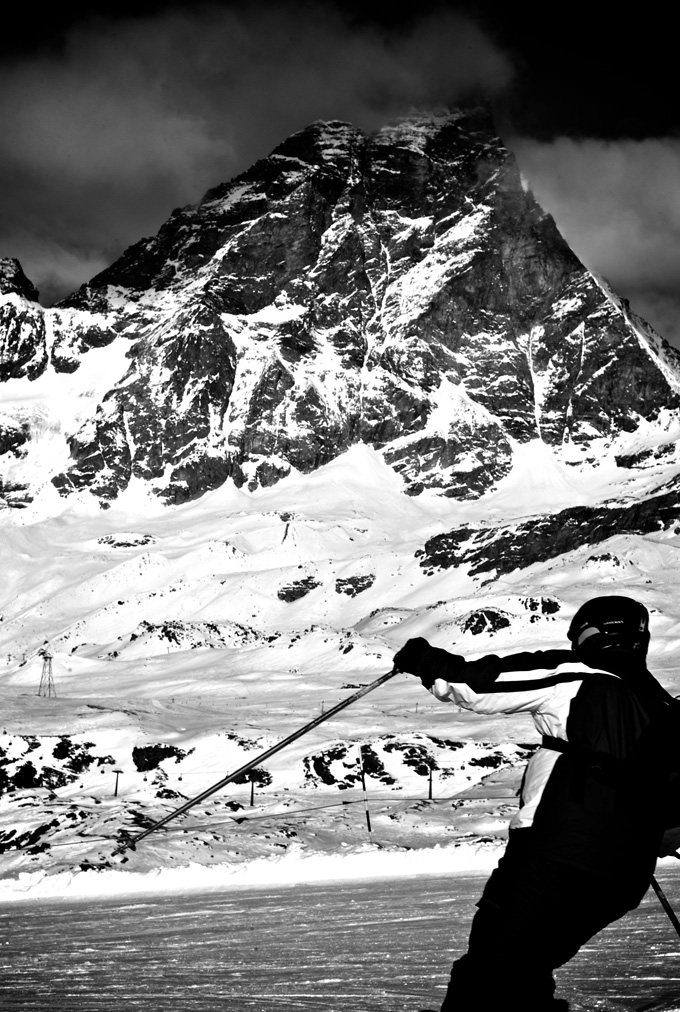

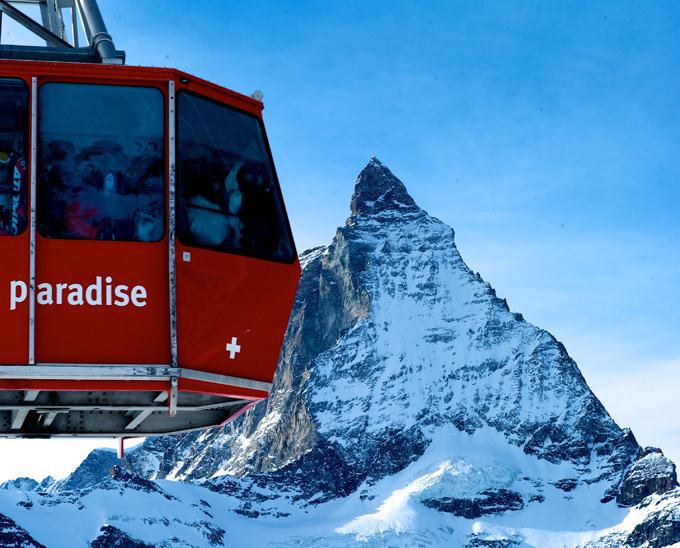

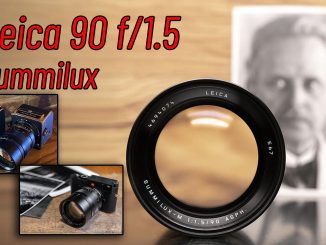

I have the same feeling about mountains! High altitude, blue skies and majestic peaks are a perfect subject for photography. not as easy as people think to capture amazing shots especially when you are carrying gear in snow and cold temperatures and using a lot of energy just to get around. You’re making a great start with these pictures. i like the first and last photos the best. The more time you spend on the slopes the more great shots you’ll get so you’ve got a great excuse to go back again!!!
Steve I’ll pardon that type of comment all day long 🙂 Thanks for taking the time to look and comment.
pardon my french but the last image is f*cking stunning.
Another vote for the last pic !
Greg
.
Darell, for “A Beginner’s Experience” these are great holiday mementos, great first shots, gorgeous blue skies. That first shot at the top of the piece, that’s got artistry to it: your eye follows the line coming down from the Matterhorn peak to the lower-right corner; that sharp edge descending to the right very nicely contrasts the pale sky against the dark mountainside; your eye constantly runs up and down that right-hand mountain edge, looking for more and more detail.
That wouldn’t have been shot at f1.4, I guess (..Leica EXIF files don’t record which aperture was used, but only shutter speed and ISO setting, etc.) and f5.6 or f8 would have been perfectly OK for that. But your moon shot (‘Early start for the slopes’) was taken at ISO 640 ..and at 1/6000th of a second! ..Darell! ..For denser morning or evening colours reduce the ISO, and you really don’t need 1/6000th for something that’s barely moving (..unless YOU were..), so reduce the aperture so that you can get the whole shot in sharp focus if you want ..like your “Heaven-is-a-Place-on-Earth” solitary standing skier, shot at ISO 160 ..but you could have closed down the aperture a bit more, as it didn’t really need a shutter speed of 1/750th! Maybe if you’d moved a little to your left, the distracting strings and poles near that left arm would have disappeared out of the picture.
These pics are, as you say, “a beginning”. Though photos take just a fraction of a second to shoot, the results are usually meant to last for years. So BEFORE shooting, think how much of the picture you want in sharp focus – from here to there – and then choose an aperture accordingly (..smaller aperture, more in focus). See if you can create a great composition which you’ll want to look at over and over. (The shutter speed’s fairly immaterial for static shots like most of these.)
Look at Ashwin’s photo: it has ‘composition’ ..a nice wavy line of trees, mist above, and – rising out of the mist, and out of a dip in the trees – the mountain itself, emerging from a veil of mystery. Some thought has gone into shooting that.
It was taken with a lens which has f4 as its maximum aperture ..at its widest it lets in only one SIXTEENTH of the light which the ‘Summilux’ does. But Ashwin’s used that to its advantage: he’s used a SMALL aperture to keep everything absolutely sharp, so that the eye can roam around the whole picture, investigate and explore it. He’s provided an adventure for the eyes to search through. You could put that picture on the wall, and keep looking at it day after day, like Ansel Adams’ photographs.
Why use – for outdoors in bright mountain light – a ‘Summilux’ at a wide aperture? ..It’s a low-light shallow-depth-of-field f1.4 lens ..a lens designed for pictures which are taken in very little light (..and with very little of the picture in sharp focus), like your contemplative “Luke Waiting” portrait.
I’d say – for what little my comments may be worth! – get to know what DIFFERENT apertures will do. Just because it’s a ‘Summilux’, that doesn’t mean that you should use it wide open most of the time.
I hope these comments are helpful and reasonably useful, and haven’t put you off! That “Heaven is a Place on Earth” solitary skier is, like Ashwin’s, a picture I could look at for hours ..because thought has gone into it ..and that communicates itself from the photographer to the viewer ..all best wishes, David.
Hi David, Thanks for taking the time to provide this level of feedback, I really do appreciate it. You’re right that a lot of these shots were not taken wide open, in fact many of my landscape shots were taken at f8. I ended up using the Summilux mainly because I really like the way it draws.
The early morning shot was however taken at a wider aperture and in a very short time frame. The short time frame because it was extremely cold and my gloves were in the car and the wider aperture because I wanted to defocus the distracting branches on the left hand side of the image that compete with the early morning sun on the mountains. As it happens its the picture in the series that I’m the least happy with and in retrospect I should have taken more time and moved around the car park to different vantage points to get a better shot and adjusted my ISO.
The final shot ties in my own preference with the first one and Luke Waiting. I do know what you mean about the poles and the string but unfortunately moving to the left was not an option for three reasons. One the skier would have seen me and quite possibly changed their pose and would not have been framed by the tree. Two, the diffuse lighting effect was caused by a snow canon firing fine snow up into the air in only one direction with the late afternoon sun filtering through it and moving to the left would have meant the skier was shot against a different light. Finally and most importantly this was on a narrow and icy run and moving to the left would have put me stationary in the middle of it, not good! I actually took about ten different images of this shot trying to minimise those poles and string but this was the best I could do. I wish it was cleaner and did consider trying to edit them out but decided to go with what was actually there.
As you say David there are definitely things I can learn about composition and the capabilities of the tools that I have. Thanks again for taking the time to give me pointers. on this.
I’m glad you found the comments useful, and many thanks for giving us all those clear explanations of why the pics are the way they are!
You certainly have the eye, and you know what you’re looking for and how to shoot it. Many thanks for responding!
Everything you say here is correct.
That said, shooting landscapes “wide open” can sometimes give pleasing results, especially if the lens is at its hyperfocal distance.
Look at
http://www.yanidel.net/2011/04/25/impressions-of-ushuaia/
for some landscapes shot on a 1.4 35 summilux wide open. Well-done I think.
Hi Darell, from across the `pond`. Great article and beautiful photos, they brought back many memories from the last time I was in that area, back in 1986. The Matterhorn never fails to impress. OK, I won`t “get you started”, but I do run a Mini Cooper S (:->)
Hey Roger, I should have made clear that I’m in the UK too and I drive a Mini Cooper BUT as I’m almost as obsessive about that as I am about photography I won’t go into the fact that both this version and the old one are just the coolest cars ever made…darn there I go again!
Hi Darell, from the southeast, east of the `pond`. Well . . . . . . you have lit the blue touchpaper now ! But I`m afraid I`ve got to admit that my Cooper S is only 4 years old, not a “real” one 🙂 Better get back to cameras, this is Steve`s “photography” site ! Always been intrigued by the Leica M`s, but wallet hasn`t been thick enough, so have had to make do with Nikon F6 and shoot `real raw`. Now, don`t get ME started on film v digital . . . . . .
PS Sorry Steve for going OT
Great article and great photos Darell! Great to see you writing an article for Steve 😉
Thanks Amy! What with this and the royal wedding it’s been a great day.
Yes it has. And my 50 lux arrived today, after a years wait.
Thanks everyone for these kind comments but thanks most of all to Steve for posting my article. It’s always nerve wracking when you put your photos out there to be seen and commented on but to have them posted here where there are so many great contributors is doubly so. I would like to encourage any of you that can to go to Steve’s meet up. You’ll meet some great people, learn a lot and have a fantastic time, unfortunately I cant make it this time, but hope to go again in the future.
The last shot is magical
Great photos – thanks for sharing. My favorite is the fifth photo. I like to “get lost” in beautiful scenery! 🙂
Glad you liked it iau. You have summed up the feeling so well, “getting lost” in the scenery is exactly how I feel, time almost seems irrelevant faced with such beauty and majesty.
Well done, Darell. Great photos and a great article. I also took the EP2 to M camera route. The EP2 is a great little camera, but the M is the one that really makes you work, and unlocks your creativity. I love your first Matterhorn shot…it really captures what it must feel like to look up at it and to feel so small and insignificant.
Thanks David, I take that as a great compliment coming from you. Folks if you haven’t seen David’s photos you should check him out on smugmug he has some really good shots posted there.
Hi Darell, great to see your pictures published here – it looks like it was a fun trip! I also like the last picture the most, but the first one (b&w version of the Matterhorn) is also very good, the b&w conversion is well done!
Thanks Felix, it was a great trip. There are some images that just convert well to B&W and the Matterhorn is one. I was trying to get a feel of the 1930’s style B&W photos of mountains and I quite like how it came out 🙂
I also like the last pic the most. The colors are amazing.
This is a stunning series, Darrell. I agree that the last is my fav, but the ones above are quite impressive. Here’s one of my own, M9 at Mt. Rainier….
[img]http://www.stevehuffphoto.com/wp-content/uploads/2011/04/New Ranier.jpg[/img]
Thank you for such kind comments Ashwin. If I can even begin to get close to the images you produce I would be amazed. Your picture of Mt Rainier is absolutely stunning atmosphere, composition and ethereal beauty.
I agree!
The last pic was the best, thanks for sharing
Thanks James, it was taken at the end of the first day and was one of those happy moments been everything just came together.